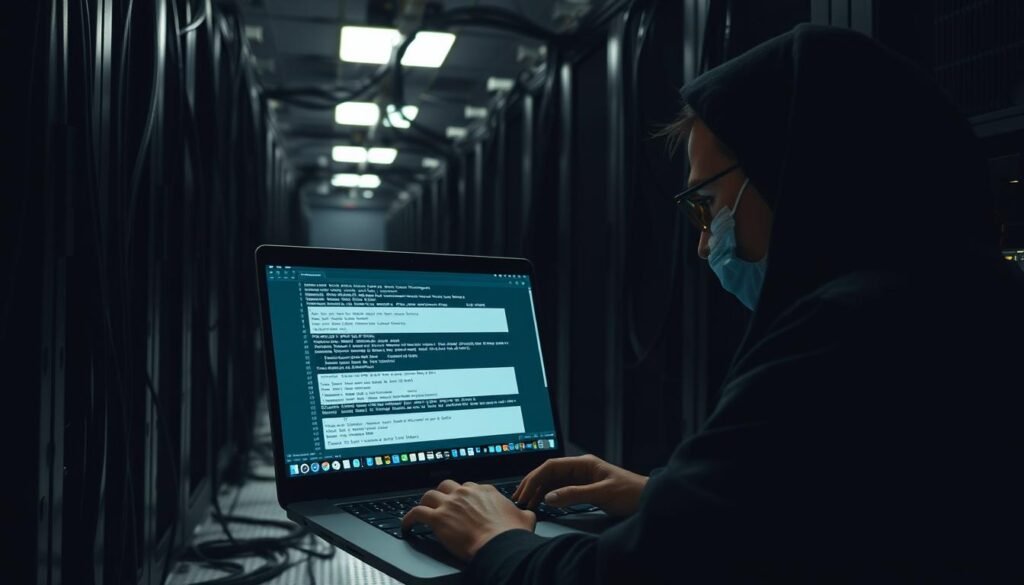Have you ever wondered how some individuals earn six figures by simply identifying vulnerabilities in software?
The world of bug bounty programs offers a unique opportunity to turn your technical skills into a lucrative career. With companies like Google, Apple, and Tesla offering substantial payouts, the potential to earn over $100,000 annually is a real possibility.
These programs reward those who can uncover critical security flaws in applications and systems. Whether you’re a seasoned professional or just starting, the right approach and persistence can lead to significant earnings. Platforms like HackerOne and Bugcrowd offer a structured environment for reporting findings and receiving compensation for your efforts.
This article will guide you through the essential steps to succeed in this field. From mastering the necessary skills to navigating popular platforms, you’ll learn how to maximise your income. Ready to explore this exciting path? Let’s dive in.
Key Takeaways
- Bug bounty programs offer substantial payouts for identifying vulnerabilities.
- Technical skills and persistence are crucial for success.
- Platforms like HackerOne and Bugcrowd are essential for reporting findings.
- Earnings can exceed $100,000 annually for top performers.
- Learning and community engagement enhance your chances of success.
Introduction to Bug Bounty Hunting
The cybersecurity industry is booming, and one of its most exciting opportunities lies in identifying software flaws. This practice, known as bug bounty hunting, has become a cornerstone of modern security strategies. Companies worldwide are offering rewards to those who can uncover and report vulnerabilities in their systems.
What is Bug Bounty Hunting?
Bug bounty hunting involves searching for and reporting vulnerabilities in software or applications. These flaws, if left unaddressed, could be exploited by malicious actors. By participating in a program, you help organizations strengthen their defenses while earning rewards for your efforts.
There are various types of vulnerabilities, such as SQL injection, cross-site scripting, and authentication flaws. The process typically involves:
- Identifying potential weaknesses in an application.
- Documenting the issue with clear steps to reproduce it.
- Submitting a detailed report through a designated platform.
Why Pursue a Career in Bug Bounties?
Many professionals are transitioning to bug bounty hunting as a side hustle or full-time career. The flexibility it offers is unmatched. You can work from anywhere, set your own hours, and choose the projects that interest you.
Another major draw is the potential for high rewards. According to recent data, the average payout for a reported vulnerability is around $1,000. Critical issues can yield rewards of $10,000 or more. Additionally, this field encourages continuous learning, keeping you updated on the latest trends and methodologies.
The role of the community cannot be overstated. Platforms like HackerOne provide a space for hunters to share advice, collaborate, and grow. Staying engaged with these networks can significantly enhance your skills and success rate.
| Benefit | Description |
|---|---|
| Flexibility | Work from anywhere, set your own schedule. |
| High Rewards | Earn substantial payouts for critical findings. |
| Continuous Learning | Stay updated on the latest security trends. |
| Community Support | Engage with experienced hunters for advice and collaboration. |
Whether you’re looking for a new career path or a way to supplement your income, bug bounty hunting offers a unique blend of challenges and rewards. With the right approach and dedication, you can turn your skills into a lucrative endeavor.
Understanding the Bug Bounty Landscape

The landscape of software security is shifting, creating a growing need for expertise in vulnerability detection. As companies increasingly rely on digital platforms, the demand for skilled individuals to identify and report flaws has surged. This section explores the current trends, opportunities, and strategies for navigating this dynamic field.
Current Trends and Opportunities
One of the most significant trends in the industry is the shift from automation to deep analysis. While automated tools can identify basic issues, complex vulnerabilities require a human touch. This change has opened doors for those with advanced technical skills and a keen eye for detail.
Emerging vulnerabilities in web applications are also reshaping the landscape. Issues like server-side request forgery (SSRF) and insecure deserialization are becoming more common. Staying updated on these trends is crucial for success.
Platforms like HackerOne and Bugcrowd are leading the way, offering structured environments for reporting findings. According to recent data, the average payout for a critical vulnerability is around $10,000, with some reports exceeding $100,000. This highlights the lucrative potential of this field.
Navigating the U.S. Market
The U.S. market is one of the most competitive in the world, with numerous programs and platforms available. To succeed, you need to choose the right platform based on your skills and experience. For example, HackerOne is ideal for beginners, while Bugcrowd offers more advanced opportunities.
Understanding the types of vulnerabilities most sought after is also key. Critical issues like remote code execution and authentication bypasses are highly valued. By focusing on these areas, you can increase your chances of earning substantial rewards.
For those getting started with bug bounty hunting, it’s essential to stay informed about the latest trends and adapt your approach accordingly. The competitive nature of the U.S. market requires continuous learning and persistence.
Essential Skills and Knowledge for Success

To thrive in identifying software flaws, mastering specific skills is non-negotiable. Whether you’re just starting or looking to level up, combining technical expertise with the right mindset is key. This section breaks down the essentials you need to succeed.
Technical Proficiencies You Need
Success in this field starts with a solid foundation in technical skills. Familiarity with web vulnerabilities like SQL injection and cross-site scripting is crucial. Tools like Metasploit and OpenVAS are indispensable for penetration testing and vulnerability detection.
Understanding network protocols and performing code reviews are also vital. These skills allow you to dissect applications and identify weaknesses effectively. Platforms like HackerOne offer free challenges to help you practice and refine these abilities.
Certifications like CompTIA Security+ can validate your expertise. Hands-on experience with tools and methodologies ensures you’re prepared for real-world scenarios. Continuous learning is essential to stay ahead in this ever-evolving field.
Developing a Hacker Mindset
Technical skills alone aren’t enough. A hacker mindset prioritizes creativity and detailed analysis over simple automation. This approach involves thinking outside the box to uncover vulnerabilities that others might miss.
Balancing creativity with rigorous adherence to security methodologies is critical. For example, exploit development requires both innovative thinking and a structured process. This mindset sets top performers apart in the competitive landscape.
Engaging with the community on platforms like Bugcrowd can also enhance your skills. Sharing advice and collaborating with others fosters growth and keeps you updated on the latest trends. With the right mindset, you can turn challenges into opportunities.
Analyzing Bug Bounty Programs and Platforms

Choosing the right platform can make or break your success in identifying software vulnerabilities. With so many options available, understanding the strengths and weaknesses of each is crucial. This section will guide you through evaluating top platforms, payout structures, and the types of vulnerabilities that yield the highest rewards.
Top Platforms and Program Evaluations
Platforms like HackerOne and Bugcrowd dominate the landscape, offering structured environments for reporting vulnerabilities. Each platform has its own guidelines and focus areas. For example, HackerOne is beginner-friendly, while Bugcrowd caters to more advanced users.
When evaluating a platform, consider these factors:
- Program Scope: Some platforms focus on web applications, while others include mobile or IoT devices.
- Support and Resources: Look for platforms that offer tutorials, forums, and mentorship opportunities.
- Reputation: Platforms with a strong track record of fair payouts and timely responses are ideal.
Understanding Payout Structures and Vulnerability Types
Payouts vary widely based on the severity of the vulnerability. Medium-level issues might earn you a few hundred dollars, while critical flaws can fetch $10,000 or more. For instance, CodeChef’s program offers rewards with no upper bound for critical severity bugs.
Here’s a breakdown of common vulnerability types and their potential payouts:
- SQL Injection: High severity, often rewarded with $1,000-$5,000.
- Cross-Site Scripting (XSS): Medium severity, typically $500-$1,500.
- Remote Code Execution: Critical severity, can exceed $10,000.
Case studies show that strategic program selection is key. For example, 1inch’s program offers rewards up to $500,000 for high-impact vulnerabilities. By focusing on platforms that align with your skills and financial goals, you can maximize your earnings.
Developing Your Bug Bounty Hunter Mindset
In the world of cybersecurity, mastering the art of vulnerability discovery requires more than just tools—it demands a mindset shift. Many participants in bug bounty programs start with automated techniques, but true success comes from diving deeper into manual analysis. This approach not only uncovers hidden flaws but also helps you understand the core logic of applications.
Shifting from Automation to Deep Analysis
Automated tools are great for initial scans, but they often miss complex vulnerabilities. To excel, you need to move beyond surface-level recon and focus on detailed manual testing. This means examining every aspect of an application, from its code structure to its business logic.
One key benefit of this approach is the ability to identify high-value vulnerabilities that others overlook. For example, during live hacking events, participants who invested time in deep analysis consistently uncovered critical issues that automated tools couldn’t detect.
Here’s how you can refine your mindset:
- Understand the Application: Study how the software works and its intended functionality.
- Think Like an Attacker: Identify potential weak points that could be exploited.
- Experiment Continuously: Test different scenarios and learn from each attempt.
By adopting this mindset, you’ll not only improve your success rate but also gain a deeper appreciation for the intricacies of cybersecurity. The journey from automation to deep analysis is challenging, but the rewards—both financial and intellectual—are well worth the effort.
Becoming a Successful Bug Bounty Hunter

Achieving success in uncovering software vulnerabilities requires a blend of strategy, persistence, and continuous learning. The journey from beginner to expert is paved with challenges, but the rewards are worth the effort. By refining your approach and learning from real-life examples, you can maximize your potential in this field.
Strategies to Identify High-Value Vulnerabilities
One of the most effective strategies is to focus on overlooked areas of an application. Many hunters rely on automated tools, but manual analysis often uncovers hidden flaws. For instance, elite hunters frequently experiment with unexpected inputs, which can expose vulnerabilities in 10-15% of cases.
Another key tactic is to monitor server responses when modifying inputs. This method reveals security gaps in around 30% of scenarios. Combining different attack techniques, such as SSRF with Open Redirect, can also yield significant results.
Here are some actionable steps to improve your process:
- Study API Documentation: Undocumented features often lead to critical findings.
- Experiment with Inputs: Test unexpected modifications to uncover hidden flaws.
- Analyze Business Logic: Understand how the application works to identify weak points.
Real-Life Case Studies and Insider Tips
Dr. Katie Paxton-Fear, a former data scientist, transitioned to bug bounty hunting after discovering vulnerabilities in Uber’s system during a live hacking event. Her success highlights the importance of persistence and continuous learning. She emphasizes that every expert was once a beginner, and incremental skill development is key.
Another example involves elite hunters who focus on subdomains and race conditions. These subtle details are often missed but can lead to critical vulnerabilities. By refining your analysis methods, you can increase your chances of success.
Here’s a comparison of common strategies and their success rates:
| Strategy | Success Rate |
|---|---|
| Manual Analysis | 30% |
| Unexpected Inputs | 15% |
| Combining Techniques | 20% |
Staying motivated during periods of low activity is crucial. Engage with the community, participate in challenges, and keep learning. As one experienced hunter put it, “Every missed detail is an opportunity to learn and improve.”
Monetization and Income Strategies

Building a sustainable income in cybersecurity requires careful planning and strategic financial management. Whether you’re just starting or already established, understanding your financial needs is crucial. This section will guide you through calculating your bare minimum income, creating a financial runway, and setting realistic quarterly goals.
Calculating Your Bare Minimum and Runway
Start by determining your bare minimum monthly income. This is the amount you need to cover essential expenses like rent, utilities, and groceries. List all your fixed and variable costs to get a clear picture. For example, if your monthly expenses total $3,000, this is your bare minimum.
Next, create a financial runway to cover 3-6 months of living expenses. This safety net ensures you’re prepared for low-earning periods. If your bare minimum is $3,000, aim to save $9,000-$18,000. This buffer provides peace of mind and financial stability.
Setting Realistic Quarterly Goals
Break down your income goals into quarterly targets. This approach makes it easier to track progress and adjust strategies. For instance, if your annual goal is $60,000, aim for $15,000 per quarter. This helps you stay focused and motivated.
Consider diversifying your income streams. Here’s a breakdown of potential sources:
- Pentests: Conducting penetration tests can provide steady income.
- Sponsorships: Partnering with companies for sponsored projects.
- Bug Bounty Rewards: Earnings from identifying vulnerabilities in programs.
Managing income fluctuations is key. During high-earning periods, save more to cover future lows. For example, if you earn $10,000 in a month, allocate a portion to your runway fund. This strategy ensures you’re prepared for unpredictable cycles.
| Income Stream | Potential Earnings |
|---|---|
| Pentests | $5,000-$10,000 per project |
| Sponsorships | $2,000-$5,000 per partnership |
| Bug Bounty Rewards | $1,000-$10,000 per vulnerability |
By following these steps, you can achieve financial stability and maximize your earnings. For more tips on how to become a bug bounty, explore additional resources and community forums. With the right approach, you can turn your skills into a rewarding career.
Managing Risk and Overcoming Plateaus

Facing challenges is inevitable in any field, but how you handle them defines your success. In the world of bug bounty programs, there will be times when progress feels slow or nonexistent. These moments, often called “bugless nights,” can be frustrating, but they’re also opportunities to refine your skills and strategies.
Navigating Bugless Nights
It’s common to experience periods where no vulnerabilities are found. Instead of feeling discouraged, use this time to reassess your approach. Review past reports, study new methodologies, and experiment with different tools. Many successful hunters turn these quiet phases into learning opportunities.
Here are some practical steps to stay productive:
- Document Your Process: Keep a detailed log of your testing methods and findings. This helps identify patterns or gaps in your approach.
- Engage with the Community: Share your experiences and seek advice from others. Platforms like HackerOne offer forums where you can learn from peers.
- Set Short-Term Goals: Break down your tasks into smaller, manageable objectives. This keeps you focused and motivated.
Learning from Setbacks and Adjusting Techniques
Setbacks are part of the process, but they can also be opportunities for growth. When a strategy doesn’t yield results, it’s time to recalibrate. For example, if automated tools aren’t effective, shift to manual analysis. This deeper approach often uncovers vulnerabilities that machines miss.
Successful hunters emphasize the importance of persistence. Dr. Katie Paxton-Fear, a renowned expert, once said, “Every missed detail is a chance to learn and improve.” By staying adaptable and open to change, you can turn challenges into stepping stones.
Here’s a comparison of strategies and their effectiveness:
| Strategy | Effectiveness |
|---|---|
| Manual Analysis | High |
| Automated Tools | Moderate |
| Community Engagement | High |
Quantifying your performance is also crucial. Track the number of tests conducted, vulnerabilities found, and time spent. This data helps you identify areas for improvement and measure progress over time. Remember, every expert was once a beginner. With persistence and the right mindset, you can overcome plateaus and achieve long-term success.
Leveraging Community and Networking in Cybersecurity
Building a strong network in cybersecurity can significantly enhance your career growth and open doors to new opportunities. Engaging with like-minded professionals allows you to share knowledge, gain insights, and stay updated on the latest trends. Whether you’re a beginner or an expert, the community plays a vital role in your success.
Engaging with Bug Bounty Communities
Connecting with other security professionals is essential for career growth. Platforms like HackerOne and Bugcrowd offer forums where you can interact with peers, ask questions, and share experiences. These communities provide a wealth of knowledge and support, helping you refine your skills and stay motivated.
Social media groups and online meet-ups are also great ways to engage. Platforms like LinkedIn and Twitter host discussions on the latest vulnerabilities and methodologies. By participating actively, you can build relationships and gain valuable advice from experienced professionals.
Collaborative Learning and Industry Events
Attending industry events like BSides and DEFCON can be transformative. These conferences offer workshops, talks, and networking sessions that deepen your understanding of cybersecurity. They also provide opportunities to meet industry leaders and potential collaborators.
Collaborative learning is another powerful tool. Working with peers on challenges or projects can uncover new perspectives and techniques. For example, many hunters have found breakthroughs by discussing their findings with others in the community.
Here’s a breakdown of the benefits of networking in cybersecurity:
| Benefit | Description |
|---|---|
| Knowledge Sharing | Learn from others’ experiences and insights. |
| Career Opportunities | Discover job openings and collaborations. |
| Skill Development | Enhance your expertise through peer feedback. |
| Motivation | Stay inspired by engaging with passionate professionals. |
By leveraging these opportunities, you can accelerate your growth and achieve your goals. For more insights on leveraging bug bounty hunters, explore additional resources and community forums. Networking is not just about making connections—it’s about building a foundation for long-term success.
Conclusion
Turning your technical skills into a rewarding career in cybersecurity is within reach with the right strategies. This article has highlighted the importance of continuous learning, persistence, and strategic planning to succeed in bug bounty programs. By mastering essential skills and leveraging platforms like HackerOne, you can unlock significant earning potential.
Real-life success stories demonstrate that a proactive approach and adaptability are key. Whether you’re identifying vulnerabilities or navigating challenges, staying motivated and refining your techniques will set you apart. Remember, every setback is an opportunity to grow.
To achieve your income goals, balance skill development with financial planning. Set realistic targets, diversify your income streams, and build a financial runway for stability. Engage with the community to stay updated and inspired.
Ready to take the next step? Explore additional resources and courses to deepen your knowledge. With dedication and the right mindset, you can turn your passion for cybersecurity into a thriving career.
FAQ
What is bug bounty hunting?
Why should I consider a career in bug bounties?
What are the current trends in the bug bounty landscape?
How do I navigate the U.S. bug bounty market?
What technical skills are essential for success?
How can I develop a hacker mindset?
Which platforms are best for bug bounty hunters?
How do payout structures work in bug bounty programs?
What strategies help identify high-value vulnerabilities?
How can I set realistic income goals in bug bounty hunting?
How do I overcome plateaus in bug bounty hunting?
Why is networking important in cybersecurity?
Source Links
- How to Earn Bug Bounties with GitHub: A Practical Guide for Beginners
- How to Find Vulnerabilities for Bug Hunting 🕵️♂️💻
- The Biggest Bug Bounty Payouts of Lifetime! 2025 → Bug Bounty Blogs
- Bug Bounty Hunting — Complete Guide (Part-116)
- GitHub – rix4uni/medium-writeups: This repository updates latest Bug Bounty medium writeups every 10 minutes, https://readmedium.com/Medium_URL, https://archive.ph/Medium_URL, https://freedium.cfd/Medium_URL
- Meet Rahul Kankrale: From A Cyber Attack Victim To Top Bug Bounty Hunter
- How a researcher earned $100,000 hacking a Facebook server
- How to Become an Ethical Hacker in 2025?
- How Long Does It Take to Become an Ethical Hacker?
- Analyzing the 1inch Security Incident – CryptoRobotics
- Bug Bounty Program | CodeChef
- Cyber threat hunters uncover vulnerabilities in a network | McAfee
- Cracking The Code: How Bug Bounty Rewards Works
- The Mindset of a Successful Bug Bounty Hunter: Think Like a Hacker, Act Like a Scientist
- Top 15 Best Tools You Need to Become a Pro Bug Bounty Hunter [UPDATED 2025]
- From Accidental Hacker To Cybersecurity Champion
- How To Earn Money As A Student In 2024: 15+ Easy Ways – GeeksforGeeks
- 40 Easy Ways to Earn Money Online in India (Guide 2025)
- Planet — WordPress.org
- The Spoopiest Skeletons — Roleplayer Guild
- Beyond pentesting & bug bounty: Finding the right security mix
- How a Hacker Mindset Can Save Your Business from Catastrophic Cyberattacks
- Cybersecurity Snapshot: CSA Outlines Data Security Challenges and Best Practices, While ISACA Offers Tips To Retain IT Pros
- Bug Bounty Hunting with Censys: Finding an Unsecured Elasticsearch Instance and Reporting It
- A hacker breaks down Netflix’s new show, Zero Day | @Bugcrowd
